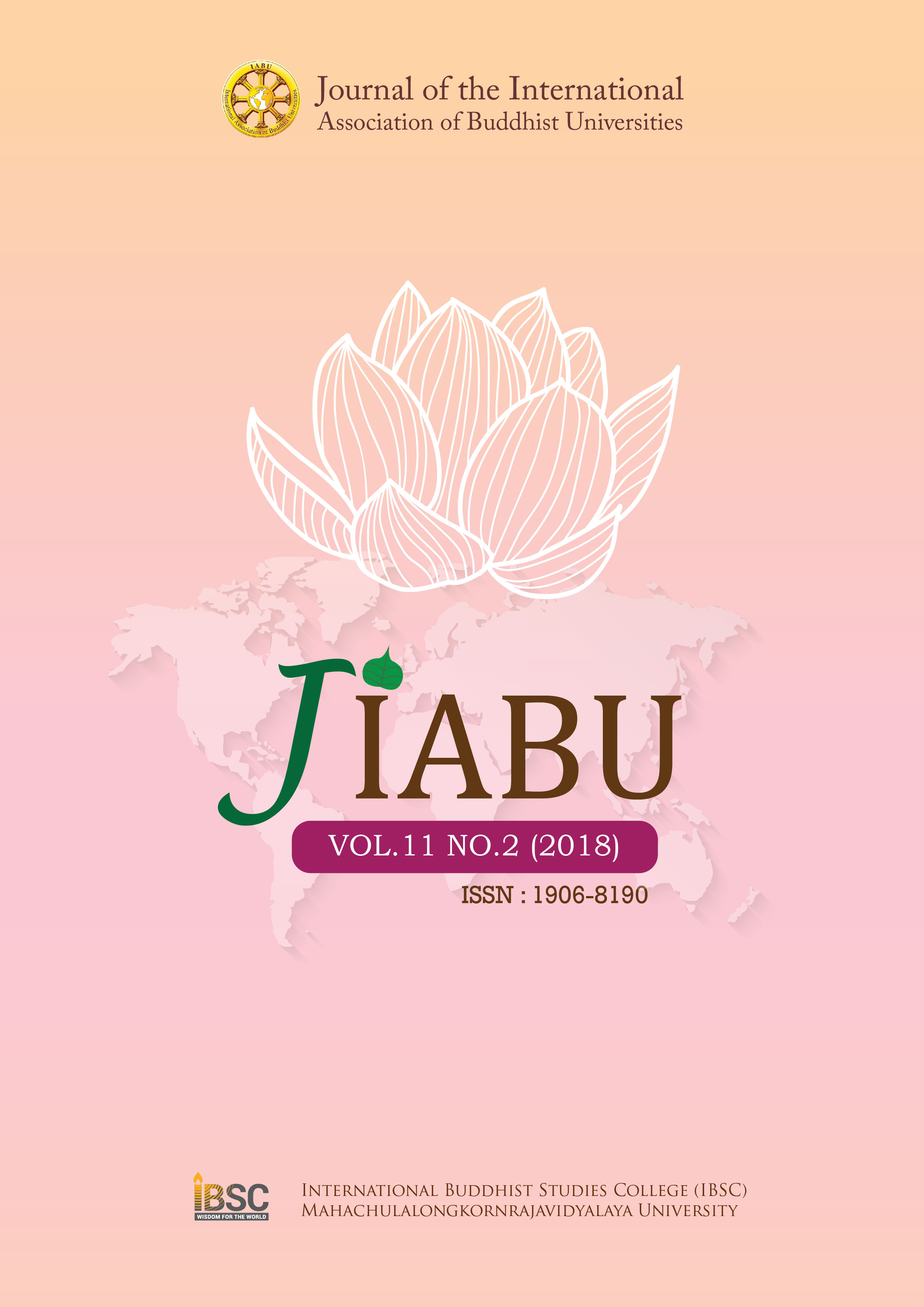A Study of Meditation Effect on The Brain and Emotional Happiness by MiRi Scan
Main Article Content
Abstract
The objectives of this study are as follows: 1) to measure and compare the cerebral
cortical thickness (CT) at straight gyrus of the frontal lobe in three eligible groups: a) Longterm meditation practitioners, b) Short-term meditation practitioners, and c) Non-meditation
practitioners; 2) to measure and compare physiological changes of neurons in the putamen (the
part of basal ganglia) of all eligible groups by advanced MRI technique, called “Fractional
Anisotropy (FA)”; and 3) to measure and compare the Happiness score (HS) among three
eligible groups. The study was experimental research in nature. The population of the study
comprised 256 healthcare providers in Kasemrad International Hospital by randomized
interviews for those eligible for the study from October to December 2015. The samples of
the study included 30 eligible cases divided into three groups, namely, 10 cases of Long-term
meditation practitioners (LTM), 10 cases of Short-term meditation practitioners (STM),
and 10 cases of Non-meditation practitioners (NM). Tools of data collection were MRI and
questionnaire. Statistics used for analyzing data composted of Percentage, Mean, Standard
Deviation and Pearson correlation.
Article Details
Views and opinions expressed in the articles published by The Journal of the International Association of Buddhist Universities (JIABU), are of responsibility by such authors but not the editors and do not necessarily reflect those of the editors.
References
Press, B.E. 2539.
Mahamakutrajavidyalaya. Pali Tipitakas. Bangkok: Mahamakutrajavidyalaya Press, B.E.
2525.
Narada Mahathera. A Manual of Abhidhamma. Kandy: BPS., 1975.
T.W. Rhys Davids, J.E. Carpenter and W. Stede. Digha-Nikaya Atthakatha: Sumangalavilasini.
3 Vols. London: PTS., 1886
T.W. Rhys Davids. Adhidhammatthasangaha. London: PTS., 1884.
T.W. Rhys Davids. The Pali Text Society (PTS). London: England, 1894
Bapat P.V. 2500 Years of Buddhism. New Delhi: Govt. of India, 1956.
Collin S. Selfl ess Persons. Imagery and Thought in Theravada Buddhism. London: Cambridge
University Press, 1981.
Dale Purves. Neuroscience. 4th Edition, Sunderland, Massachusettes: Sinauer Associates,
Inc., 2008.
Hills, P., & Argyle, M.The Oxford Happiness Questionnaire: a compact scale for the
measurement of psychological well-being. Personality and Individual Differences.
Oxford: 2002.
Phra Dhammapitaka, (P.A. Payutto). Buddadham. Bangkok: Mahachulalongkornrajavidyalaya
Press, B.E. 2015.
Stein J. and Stoodley CJ. Neuroscience. Chichester West Sussex: England, John Wiley &
Sons Ltd., 2006.
Susumi Mori. Introduction of Diffusion Tensor Imaging. 1st Edition, Baltimore: 2007
Bangert, M. and E.O. Altenmuller. Mapping Perception to Action in Piano Practice: a
Longitudinal DC-EEG Study. Boston: BMC Neurosci, 2003.
Bao, S., E.F. Chang, J. Woods and M.M. Merzenich. Temporal Plasticity in the Primary
Auditory Cortex Induced by Operant Perceptual Learning. Paris: Nat Neurosci,
2004.
Bihan, Le D. and E. Breton. “Imagerie de Diffusion In-vivo Par Résonance”. New York:
Acad Sci, 1985.
Bowden, D., C. Gaudry, S.C. An and J. Gruzelier. A Comparative Randomised Controlled
Trial of the Effects of Brain Wave Vibration Training, Iyengar Yoga and Mindfulness
on Mood, Well-being and Salivary Cortisol. California: 2012.
Brefczynski-Lewis, JA, A. Lutz, H.S. Schaefer, D.B. Levinson and R..J. Davidson. Neural
Correlates of Attentional Expertise in Long-term Meditation Practitioners. Boston:
Proceedings of the National Academy of Sciences, 2007.
Chloe, H. And Enrico de Vita., et al. “Voxel-based Cortical Thickness Measurements in MRI
”.Boston: Neuroimage, 2008.
Craig, A.D.. Interoception: the Sense of the Physiological Condition of the Body. Curr Opin
Neurobiol, NewYork: 2003.
Gray, J.R., T.S. Braver and M.E. Raichle. Integration of Emotion and Cognition in the Lateral
Prefrontal Cortex. Michigan: Proc Natl Acad Sci, 2002.
Critchley, H.G., S. Wiens, P. Rotshtein, A. Ohman and R.J. Dolan. Neural Systems Supporting
Interoceptive Awareness. New York: Nat Neurosci, 2004.
Damasio, A.R.. The Somatic Marker Hypothesis and the Possible Functions of the Prefrontal
Cortex. Boston: Philos Trans R Soc Lond B Biol Sci, 1996.
Draganski, B., C. Gaser, V. Busch, G. Schuierer, U. Bogdahn and A. May. Changes in Grey
Matter Induced by Training. Boston: Nature, 2004.
Fischl, B. And A.M. Dale. Measuring the Thickness of the Human Cerebral Cortex from
Magnetic Resonance Images. California: Proc Natl Acad Sci USA, 2000.
Friston, K.J., A. Holmes, J.B. Poline, C.J. Price and C.D. Frith. Detecting activations in PET
and fMRI: Levels of Inference and Power. New York: Neuroimage, 1996.
Friston, K.J., K.J. Worsley, R.S.J. Frackowiak, J.C. Mazziotta and A.C. Evans. Assessing
the Significance of Focal Activations Using Their Spatial Extent. NewYork: Human
Brain Mapping, 1994.


